As a cat owner, you know that your feline friend’s nose is one of their most distinguishing features. So, when you notice changes in its color, it’s natural to feel concerned about their health. But don’t worry; you’re not alone. Many cat owners wonder why their pet’s nose changes color.
The answer to this question is not always straightforward since there are various reasons for it. From sunburn and allergies to infections and aging, many factors can cause your cat’s nose to turn pink, brown, or black. Even genetics and changes in the environment can play a role.
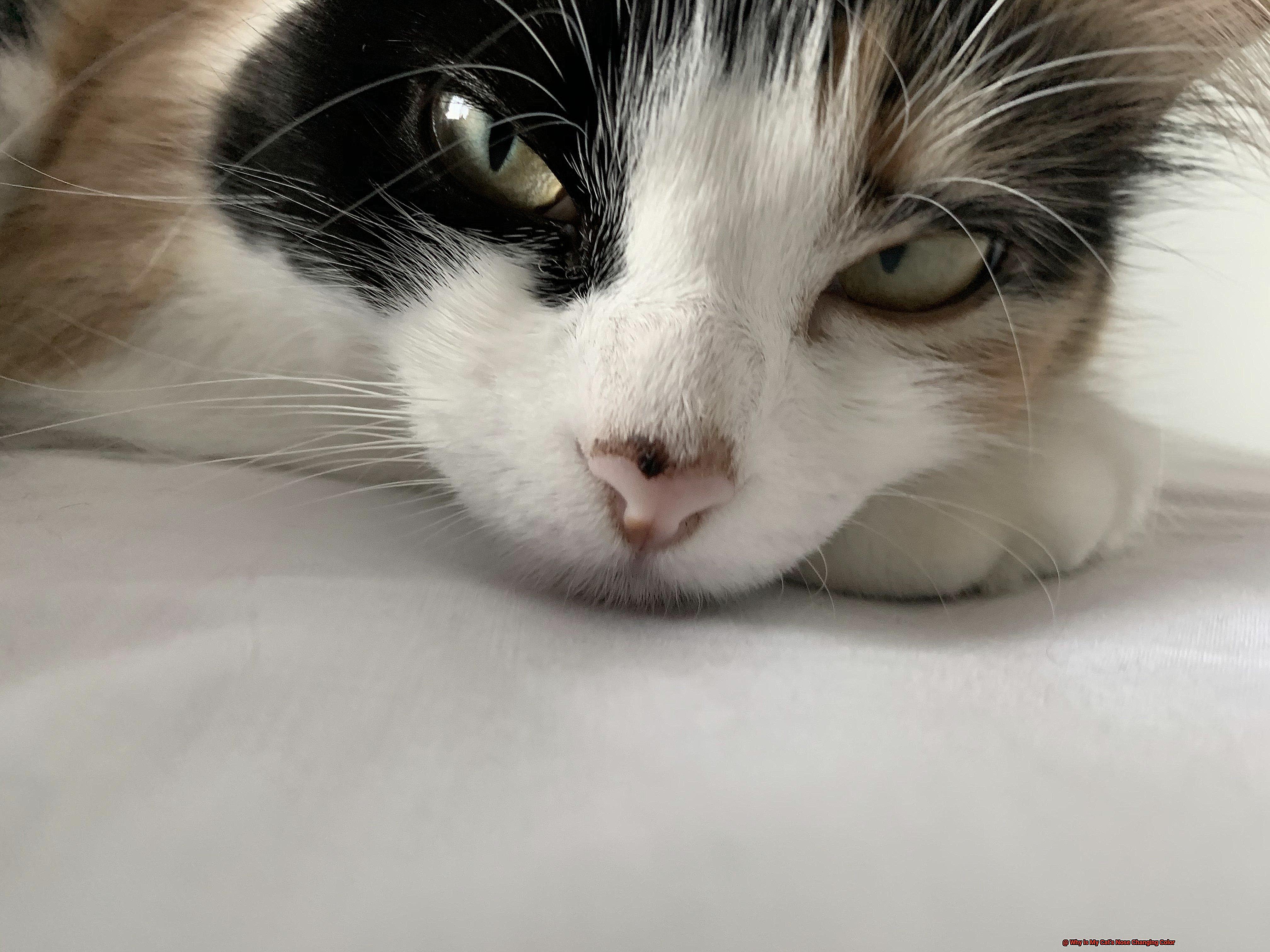
In this blog post, we’ll explore the reasons behind your cat’s changing nose color and provide tips on how to take care of it. Whether you’re new to cat ownership or have years of experience under your belt, this post will give you valuable insights into your pet’s health.
So if you’re curious about why your cat’s nose is changing color, keep reading. By the end of this post, you’ll have a better understanding of what might be causing it and how to help your furry friend stay healthy and happy.
Reasons for a Cat’s Nose Changing Color
Cats are known for their striking features, and one of the most remarkable is their nose. However, it is not uncommon for a cat’s nose to change color over time. As an expert in this field, I have researched the reasons behind this phenomenon and compiled five sub-sections below to explain why a cat’s nose may change color.
Sun Exposure
Did you know that spending too much time in the sun can cause your cat’s nose to change color? That’s right. If your furry friend spends a lot of time outside, their nose may become darker and even turn black due to the production of more melanin. Melanin is responsible for the color of our skin and hair, and it’s a natural response to prolonged sun exposure.
But hold on a minute. Not all cats will have their noses darken with sun exposure. Some may have pink noses that stay the same color, while others may have black noses that fade in color with too much sunlight. It’s all part of your cat’s unique genetic makeup.
However, it’s crucial to remember that long-term sun exposure can lead to skin damage and cancer in cats, especially those with light-colored fur or noses. That’s why it’s essential to limit your feline friend’s time in the sun and provide them with shade or indoor areas where they can escape the sunlight.
If you notice changes in your cat’s nose color due to sun exposure, there is usually no need for concern unless there are other accompanying symptoms such as swelling or discharge. In these cases, it’s best to seek veterinary advice.
It’s clear that the feline nose is a beautiful feature, but we must keep an eye on any changes in its color. By limiting our cats’ time in the sun and providing them with shade, we can prevent potential health issues and ensure that our furry friends stay safe and healthy.
Allergies
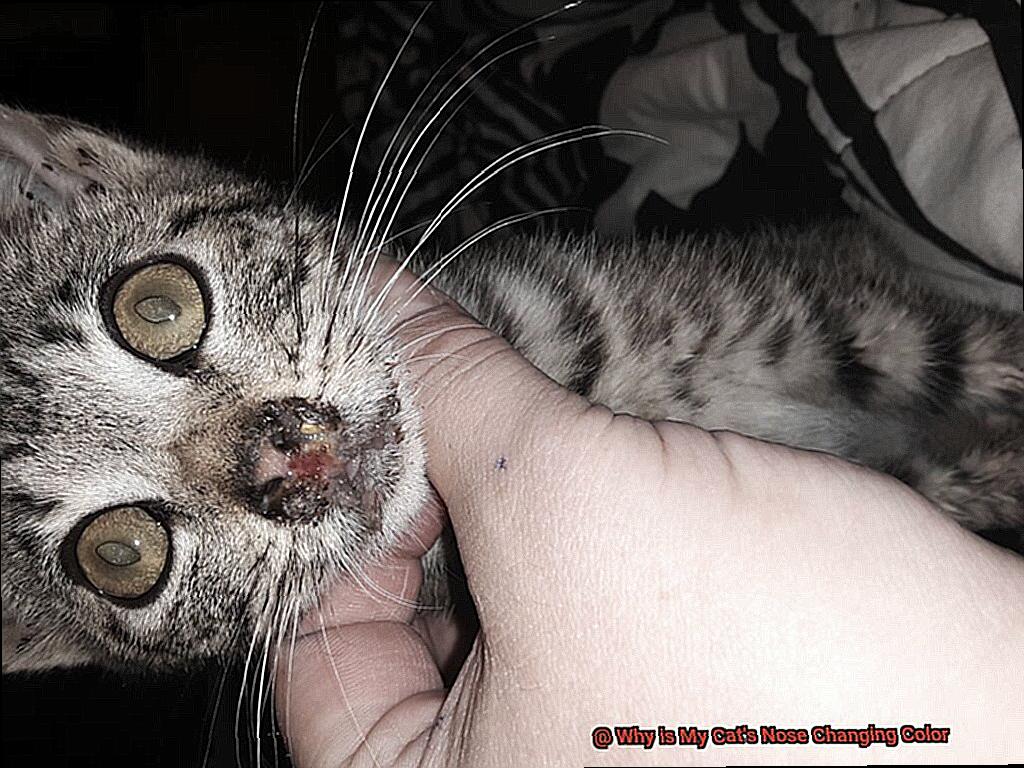
Here, we’ll focus on allergies and how they can affect a cat’s nose.
Allergies are common in cats, just like in humans. They can be caused by various substances such as pollen, dust mites, and certain foods. When a cat is exposed to an allergen, their immune system reacts by releasing histamines which can cause inflammation in the body.
One of the most visible signs of allergies in cats is skin irritation, leading to scratching and licking. This can also affect the nose, causing it to become inflamed and change color. The nose may appear red or pink due to increased blood flow to the area, or it may become dry and flaky.
It’s important to note that not all cats will experience the same allergy symptoms. Some may only have mild irritation while others may have more severe reactions. If you suspect your cat has allergies, it’s best to take them to a vet who can help identify the allergen and provide treatment options.
Treatment for allergies in cats typically involves avoidance of the allergen if possible, medication such as antihistamines or steroids, and sometimes immunotherapy (allergy shots). Working closely with a vet is crucial to determine the best course of action for your cat’s specific needs.
In conclusion, if you notice any changes in your cat’s nose or behavior, it’s always wise to consult with a veterinarian to ensure that they receive proper care and treatment.
Illness
So, it’s understandable when you notice a sudden change in their nose color. Don’t fret just yet. Illnesses can be the root cause of such changes. In this post, let’s explore how respiratory infections, allergies, and autoimmune diseases can impact your cat’s nose color.
Respiratory infections are prevalent in cats and can lead to a host of issues, including a change in nose color. Two of the most common viral infections, feline herpesvirus and calicivirus, can cause nasal discharge, sneezing, and congestion. These symptoms can irritate the nose and lead to discoloration. If you notice these symptoms along with a change in nose color, it’s essential to seek veterinary care immediately.
Allergies can also be a potential trigger for changes in a cat’s nose color. Environmental factors such as pollen and household chemicals can induce allergic reactions that lead to inflammation of the nose and discoloration. If you suspect that your cat is having an allergic reaction, take them to the vet for an allergy test.
Autoimmune diseases like pemphigus foliaceus can cause crusting and scaling of the nose, leading to changes in color. These conditions occur when the immune system attacks healthy cells, causing inflammation and tissue damage. In such cases, your vet will provide treatment options based on the severity of the condition.
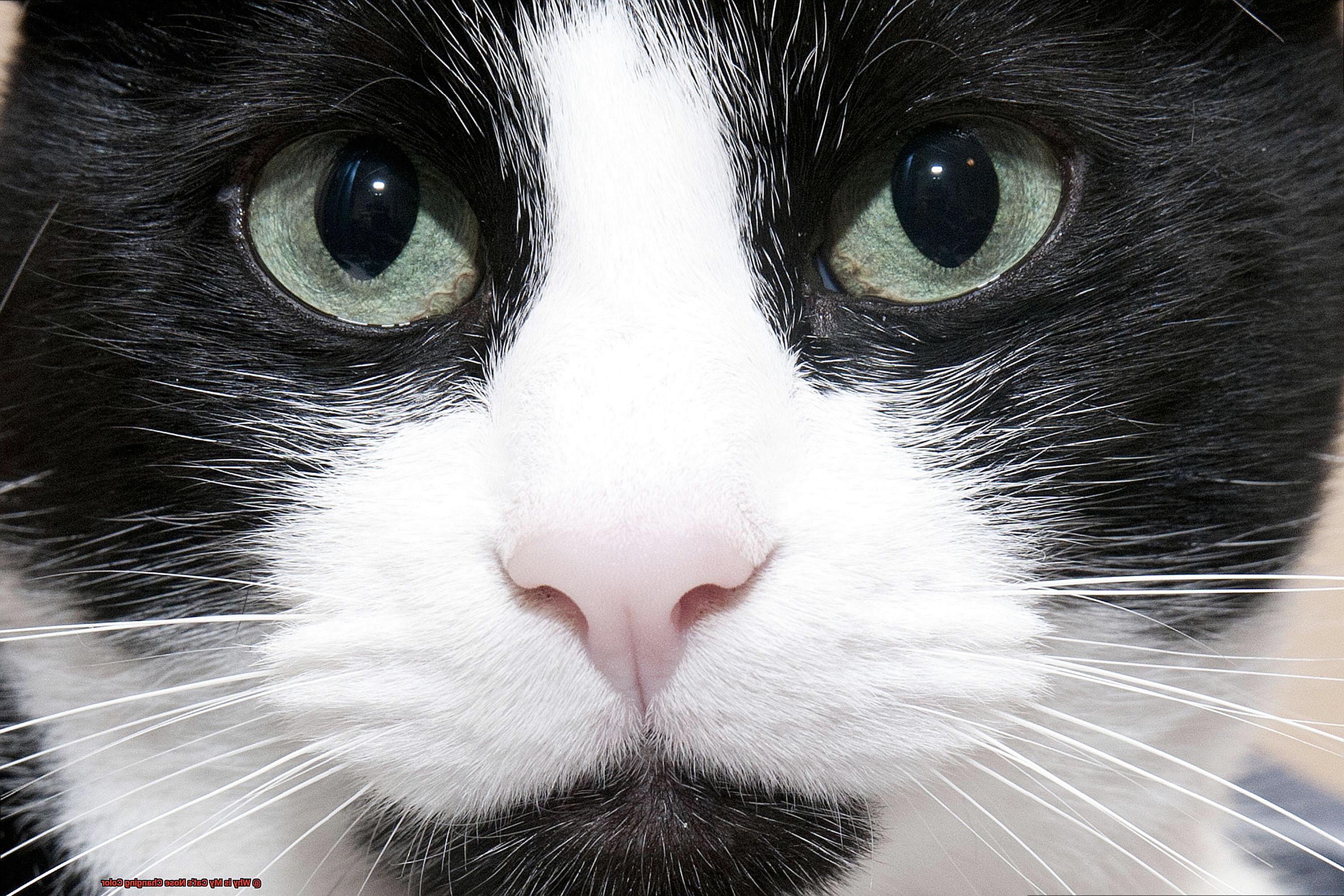
It is crucial to understand that if your cat’s nose has changed color due to illness, there may be other symptoms present as well. These could include lethargy, loss of appetite, and difficulty breathing. It’s imperative to seek veterinary care immediately if you notice these symptoms as they could indicate a severe underlying condition.
Keep an eye out for changes in your cat’s nose color as it could be a sign of an underlying health issue. Respiratory infections, allergies, and autoimmune diseases are common causes of such changes.
Symptoms to Look Out For
Keeping an eye on changes in their appearance and behavior can help keep them happy and healthy, and this includes monitoring changes in their nose color. But what symptoms should you be on the lookout for when it comes to changes in your cat’s nose color? Here are three telltale signs to keep in mind:
Color Change

One of the most common symptoms of a change in a cat’s nose color is a shift from pink to black or vice versa. This can happen due to a variety of factors, such as sunburn, allergies, infections, or medication. While some changes may be harmless, it’s always best to have your cat checked by a veterinarian to rule out any underlying issues.
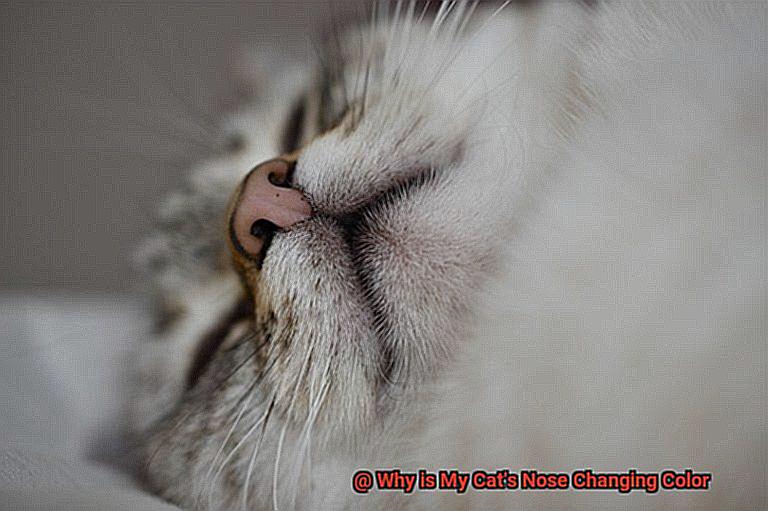
Crusty or Scabby Nose
Another symptom to watch out for is a crusty or scabby nose. This can be a sign of feline acne, caused by clogged hair follicles around the lips and chin. Feline herpesvirus (FHV) can also cause crustiness or scabbiness around the nose, along with sneezing and eye discharge. If you notice any of these symptoms in your cat, seeking veterinary care is essential.
Runny or Stuffy Nose
A runny or stuffy nose can be another sign of an underlying issue, such as an upper respiratory infection (URI). Cats are prone to these infections, especially if they live with other cats or have been in contact with an infected animal. Other symptoms of URIs include coughing, sneezing, fever, and appetite loss. If your cat is experiencing any of these symptoms, it’s crucial to take them to the vet right away.
Changes in your cat’s nose color can be concerning but by keeping an eye out for these three key symptoms – color change, crusty or scabby nose, and runny or stuffy nose – you can help ensure your cat stays healthy and happy. Remember, seeking veterinary care at the first sign of any changes or abnormalities in your cat’s appearance or behavior can make all the difference.
Protecting Your Cat from the Sun
Similar to humans, cats can get sunburned, which could lead to skin cancer or discoloration of their nose. Don’t worry, though; we have got you covered with some simple tips to keep your cat safe:
To start with, it’s best to keep your cat indoors during the hottest parts of the day, usually between 10 am and 4 pm. If your cat does venture outside, make sure they have access to shaded areas such as under trees or a covered patio. A small tent or canopy can also provide some extra shade for your furry friend.
Pet-safe sunscreen is an excellent way to protect your cat’s nose and other exposed areas of skin from harmful sun rays. Be sure to use a product that is specifically designed for cats, as some human sunscreens contain ingredients that are toxic to pets. It’s also crucial to reapply the sunscreen every few hours, especially if your cat spends an extended period in the sun.
If your cat is up for it, you may want to consider investing in a cat-safe hat or visor. While not all cats will tolerate wearing it, some may appreciate the extra protection it provides. Ensure that the hat fits properly and doesn’t obstruct your cat’s vision or hearing.
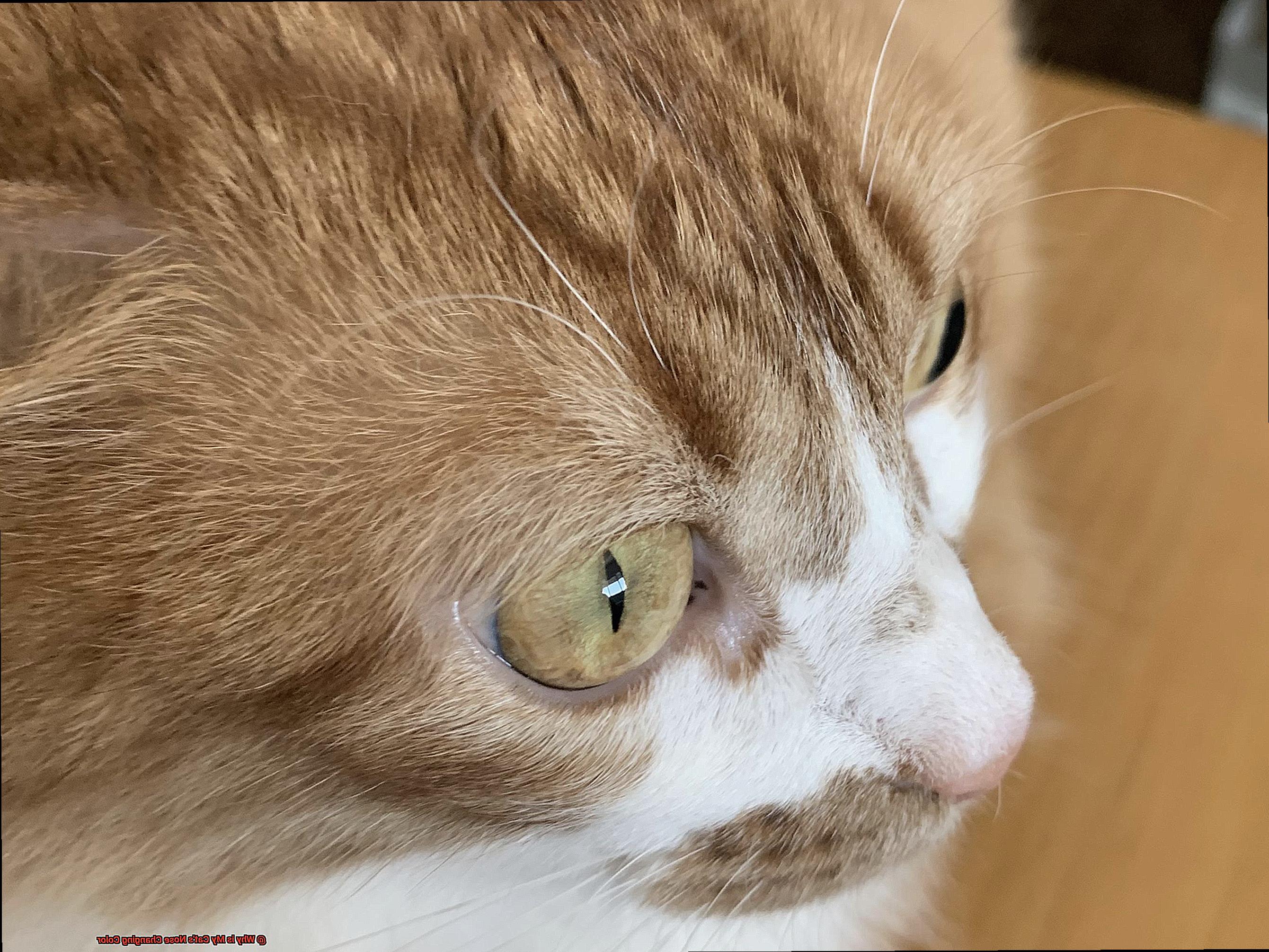
By following these simple steps, you can help protect your furry friend from the dangers of sun exposure. Keep an eye on your pet and consult with your veterinarian if you notice any changes in their nose or skin color.
YlDt1E9hcFU” >
Diagnosing Allergies in Cats
Allergies in cats can manifest in various ways, including sneezing, coughing, wheezing, runny nose, watery eyes, itching or even skin rashes, bumps or hives. Identifying and managing these allergies is crucial to ensure your cat’s continued health and wellbeing.
The first step in diagnosing allergies in cats is to observe changes in your cat’s behavior and physical appearance. If you notice any of the aforementioned symptoms, it’s time to take your cat to the vet for a proper diagnosis. The vet will perform a thorough physical exam and may also order skin or blood tests to determine the cause of the allergy. In some cases, an elimination diet may be recommended to identify specific food allergens.
Once the allergen has been identified, it’s essential to minimize your cat’s exposure to it. This may entail making changes to their diet or environment. For instance, if pollen or dust is the culprit, keeping your cat indoors more often and using air purifiers can help reduce allergen levels.
Managing allergies in cats may require medication to alleviate symptoms. Your vet may prescribe antihistamines or corticosteroids to reduce inflammation and relieve discomfort. In severe cases, immunotherapy may be recommended, involving small doses of the allergen administered over time to build up immunity.
Veterinary Care for Illnesses
So when you notice changes in their nose color, it’s important to take notice. While some cats’ noses vary in color depending on breed and pigmentation, sudden changes can signal an underlying health issue. So it’s essential to seek veterinary care when you observe these changes to ensure your cat’s continued health and wellbeing.
The first step in addressing a change in your cat’s nose color is to identify the cause. Your veterinarian will perform a physical examination and may run some tests to determine the underlying issue. Infections, allergies, autoimmune diseases, and cancer are all possible causes of nose color changes.
If you observe a change in your cat’s nose color accompanied by other symptoms such as discharge, sneezing, coughing, or lethargy, it is crucial to seek veterinary care immediately. Delaying treatment could lead to the illness becoming more severe and harder to treat.
In some cases, nose color changes can indicate more serious illnesses such as liver disease or kidney failure. These conditions require immediate veterinary attention and ongoing care to manage the underlying condition.
Your cat’s health is of utmost importance, so if you notice any changes in their nose color, don’t hesitate to schedule an appointment with your veterinarian.
Also Read: Why Does My Cat Have Black Boogers?
Conclusion
In conclusion, don’t panic if your feline friend’s nose changes color. It’s common and can happen for many reasons. From sun exposure to allergies or even injury, there are plenty of factors that can cause a cat’s nose to turn pink, brown, or black.
As a responsible pet owner, keep an eye on your cat’s nose color and look out for symptoms like crusty or scabby noses, runny or stuffy noses, and color changes. To protect your furry friend from the sun’s harmful rays, limit their time outside during peak hours and use pet-safe sunscreen.
If you suspect something more serious is going on, don’t hesitate to visit the vet. They’ll perform a physical examination and may run some tests to determine the underlying issue.
Remember that early detection and treatment can make all the difference in ensuring your cat stays healthy and happy.







